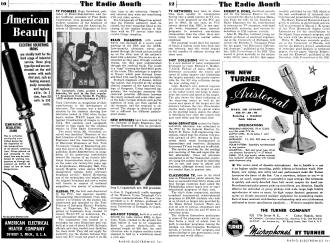|
January 1951 Radio-Electronics
 [Table of Contents] [Table of Contents]
Wax nostalgic about and learn from the history of early electronics.
See articles from Radio-Electronics,
published 1930-1988. All copyrights hereby acknowledged.
|
Radio-Electronics
magazine ran regular column entitled "The Radio Month" with industry, government,
and academic news briefs. This 1951 issue included, amongst other tidbits, a report
on TV pioneers Hugo Gernsback, publisher of Radio-Electronics, and Isidor
Goldberg, president of
Pilot Radio Corporation,
having been presented scrolls by student members of the Institute of Radio Engineers
and the American Institute of Electrical Engineers at New York University in recognition
of their contributions to the development of television. Pilot Radio manufactured
kits for electronics hobbyists. In other news, the FCC discovered its first instance
of an illegal television broadcast. It never takes long for the criminally insane
to corrupt a good thing; however, in this case it was a Sylvania Electric Products
test site operating without a license. Evidently they had adopted the philosophy
of "It's easier to beg forgiveness than to ask for permission", given that FCC still
had a ban on issuing new TV broadcast licenses at the time.
The Radio Month

Mr. Gernsback, right, accepts a scroll honoring his part in the
first regular TV broadcasts from Emilio M. Pacifico, AIEE student branch chairman
at NYU.
TV pioneers Hugo Gernsback, publisher of Radio-Electronics, and Isidol' Goldberg,
president of Pilot Radio Corporation, were presented scrolls by student members
of the Institute of Radio Engineers and the American Institute of Electrical Engineers
at New York University in recognition of their contributions to the development
of television. The occasion was a demonstration by the students showing how television
looked in 1928 when Gernsback's station WRNY began the first regular broadcasting
of images in New York. The students used equipment similar to that made for the
original station by Pilot Radio Corporation.
The scroll which Mr. Gernsback received was inscribed "Members of student branches
of the Institute of Radio Engineers and the American Institute of Electrical Engineers
at New York University College of Engineering present this scroll to Mr. Hugo Gernsback,
publisher, Radio-Electronics, in recognition of his pioneering contribution toward
the success of an historic television demonstration which took place on the same
site twenty-two years ago in Amphitheatre, Philosophy Hall, University Heights,
when station WRNY inaugurated regular daily television broadcast service." Robert
Hertzberg, one of the technicians who helped with the original broadcast and now
a writer well known to readers of technical magazines, was master of ceremonies.
Illegal TV, the first case discovered by the FCC, was reported recently. Broadcasting
intermittently from September 1 to October 19, the station was constructed and operated
by the Tube Division of Sylvania Electric Products, Inc., at Emporium, Pa. The station
picked up broadcasts from channel 13 station WJAC-TV in Johnstown, Pa., and rebroadcast
them on channel 7.
 The transmitter was located on a mountain
top near Emporium and was built at a cost of about $7,000. Sylvania officials said
they needed such facilities for their work. They did not apply for authority for
the station because they knew the FCC could not grant it at the time (due to the
television "freeze") and believed they were not interfering with any other service. The transmitter was located on a mountain
top near Emporium and was built at a cost of about $7,000. Sylvania officials said
they needed such facilities for their work. They did not apply for authority for
the station because they knew the FCC could not grant it at the time (due to the
television "freeze") and believed they were not interfering with any other service.
The townspeople of Emporium agreed that the Federal authority must be obeyed,
but were somewhat irked at the closing of the station because it left them with
no TV service other than erratic fringe reception.
Classroom TV, now in its third year in Philadelphia public schools, has been
so successful that thirty states and four foreign countries have asked the Philadelphia
school board how to start educational programs of their own.
The city's three commercial stations broadcast unsponsored, school-planned programs
to 200,000 students who look in on 16-inch or larger sets provided by the Home School
Council. There are now 40 sets in various elementary and high schools in the city
and 60 more in suburban areas.
The children themselves participate in some of the programs which take up four
hours a week of school time in half- to one-hour programs. Among the billings are
Encyclopedia Britannica movies, a "science is fun" program, and others dealing in
city government, local, national and world affairs.
Posted January 5, 2021
|











